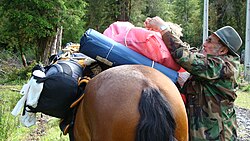Arriero

A muleteer, or more informally a muleskinner[1] (Template:Lang-es; Template:Lang-ca) is a person who transports goods using pack animals, especially mules. In South America, muleskinners transport coffee, maize (corn), cork, wheat and myriad other items. They remain common in the Paisa Region (Antioquia and the Colombian Coffee-Growers Axis) of Colombia. In California, muleteers work out of pack stations. In Europe, there are still muleteers in the south of Portugal and the southwest of Spain, in the cork producing area. Their role is now limited to transporting the cork with their mules, out of the Mediterranean oak forest to more accessible routes, where modern means of transport are available.
Names and etymology
The English word muleteer comes from the French muletier, from Old French, from mulet, diminutive of mul, mule. The term muleskinner means someone who can "skin", or outsmart, a mule.
The Spanish word arriero is derived from the verb arrear, which means to urge cattle or other stock to walk. The verb itself is derived from 'arre', which is the call used to cry out to animals for this purpose. In English, an arriero is one type of muleteer, a wrangler of pack animals.[citation needed]
The Catalan word traginer comes from the Latin word tragīnare, a variant of tragĕre which means "to transport".

Outfits
Typical muleteer outfits vary from country to country:
- Carriel: Leather bag traditionally made of nutria leather. It is used to carry personal goods and money. It has become an element of the Colombian fashion.
- Espadrilles (alpargatas) : Sandals made of fique (natural fiber obtained of furcraea plants and leather.
- Machete
- Poncho: Rectangular piece of fabric, usually white with linear embroidery, that is used to protect the face and neck from the cold weather.
- Ruana: Square wool garment, larger than the poncho, with a hole in the middle for the head. It covers the torso.
- Straw hat (sombrero aguadeño)
- Tapapinche: Leather apron.
In popular culture
The fictional Juan Valdez, brand representative of the Federación Nacional de Cafeteros de Colombia, is an archetypal muleteer carrying coffee sacks with his mule.
In Cormac McCarthy's second Border Trilogy novel, The Crossing, Billy's wolf upsets the muleteers' burros, which wreaks substantial havoc before Billy moves on.[2]
"Mule Skinner Blues" is a country music song first recorded in 1930 by Jimmy Rodgers, which has inspired may subsequent variations.

See also
References
- ^ "Mule skinner | Define Mule skinner at Dictionary.com". Dictionary.reference.com. Retrieved 2015-06-01.
- ^ McCarthy, Cormack. The Crossing. pp. 24–25 (Book Index 5).
